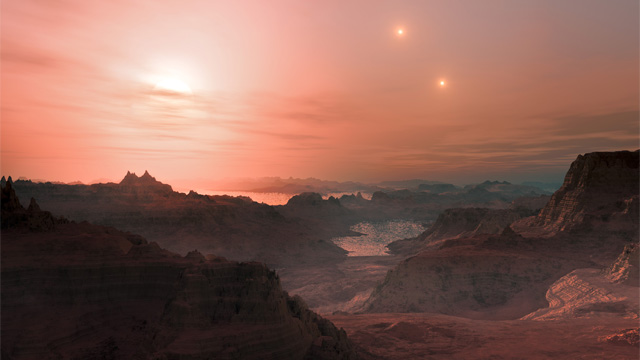
Frank Coffmann
The Last Transport
Gliese 667 Cc / GYH [Gliese Year of Habitation] 7309.91
No ship had come since 4082.
An old man now, he knew no more would come.
For many years, he’d wondered what he’d do
When his time came—on his, now loneliest, home.
Only the few and hardy had survived
Since Ares2 shot that frazzling EM burst.
For thirteen generations they had lived
As primitives. But what had been the worst
Was having that wealth of wisdom locked in text,
Each epoch striving to regain its power,
Rekindle with slow science for the next
To come—the world they’d lost in that dark hour.
So many had died of hardship, from disease,
From rampant crime, one small-scale civil war,
Before the remnants found a state of peace
And pushed on toward the goals they’d had before.
And—finally—they’d crept back to that place.
The lights came back—technology reborn.
The old tools once again could etch the face
Of that harsh world, forbidding and forlorn.
They had surprised themselves, that tiny band.
At last the terraforming was all done.
He’d found a companion, taken her hand.
They’d had three sons under the triple sun.
They’d tried again to make contact with Earth
And (now three generations) had waited for reply;3
Scanned for that mythic place of ancestral birth,
And found—Alas! a void in that distant sky.
The Earth was gone! Their world alone remained.
This home of theirs—was now all that was left
Of what that Blue Sphere’s beings had attained.
They were the remnant. Now, at the last, bereft.
But they had persevered, this New Earth theirs,
Bought with the tens of thousand deaths before,
And all the blood and toil won for their heirs
A hopeful home.…
The plague struck in 7004.
Some native pestilence had stirred awake
With their transforming of this foreign place,
This giant rock that they had dared to take,
This grain of dust in the enormity of space.
Death had spread swiftly, and the massed
Thousands who had survived on their new world
Shrunk to the very few—quick death had passed—
Immune to the plague that Fate or Fortune hurled.
Soon they discovered the ironic cost
Paid for immunity: Sterility
Beset the young and virile who weren’t lost.
No more of humankind would ever be.
The outpost signals held no hope—then stopped.
His wife and sons were gone, his kith and friends.
“Don’t let me be the last,” he’d often hoped,
But hoped in vain, “So this is how it ends?”
“Ah well, perhaps it’s best? We’ll leave this place
An Eden in this wondrous universe.
And we would very likely fall from Grace
As we’ve always done before—and still rehearse.”
“Perhaps a Paradise no longer trod by Man
Will finally our greatest offering be.
Leaving our mark is maybe all we can
Hope to bequeath to Time and Infinity.”
His last strength used to climb the gentle slope
That overlooked a landscape red and vast,
Fixing his mind on that last soothing hope,
Leaned back against a tree—and breathed his last.
Below, the fauna played, the flora thrived.
Under three suns, ‘neath constant twilight lit,
The last man on that brave, new world had lived
And died. And it seemed that it was fit.
. . . . .
Just then—in that sky that never knew the night—
One glistening golden speck in the welkin’s dome.
Larger and larger in its arching flight:
The last transport from Earth had finally come.
_______________
Author’s Notes:
1 Gliese 667 Cc is the third planet (c), orbiting star C in the triple star system Gliese 667. Orbiting its sun every 28.155 Earth days (1 3/8 days short of a lunar cycle on Earth)— hence the great number of years (7309.9 GYH is approximately 563 earth years).
2 Astronomers know that the planet is a “superterran,” being rocky and earthlike with water and atmosphere, but almost five times larger than Earth in diameter. The colonists named its red dwarf sun [Gliese 667 C] Ares, after the Greek god of war, and being very close to the planet (though a dwarf), the star appears more than three times larger than Earth’s sun does to us. Tidally locked, like Mercury in Earth’s solar system or Earth’s moon, the planet always presents the same face to the sun, thus leaving a light side of very hot to mild (130ºf avg. to 40ºf avg.) and a dark side ranging from cold to extremely cold (30ºf avg. to -325ºf avg.). The pioneers on Gliese 667 Cc set up their colonies and camps in what they came to call “The Twilight Zone,” within the bands of temperate climate on the light side, “The Lightland,” and some few rough outposts into “The Nightland” where frigid to arctic temperatures prevailed.
3 The star system of Gliese 667 C is 22 light years from Earth. Thus, it takes a minimum of 44 Earth years for a signal to reach from one to the other AND be answered.
_______________
Frank Coffman is Professor of English, Journalism, and Creative Writing at Rock Valley College, Rockford, Illinois. He has published weird, horrific, supernatural, and speculative poetry and fiction in several journals and anthologies. Founder and moderator of the Weird Poets Society Facebook site, he also selected, edited, and did introduction and commentary for Robert E. Howard: Selected Poems. He has also published a slim volume of tributary poems for Howard, Coffman Street. [so named for the happy coincidence in naming that the lane that runs by the west side of the Howard house in Cross Plains, Texas was, in Howard’s day, called Coffman Street.
Editor’s Notes: For more details about the potentially habitable planet, see https://www.mn.uio.no/astro/english/research/news-and-events/news/astronews-2012-02-17.html and https://ww2.kqed.org/quest/2013/03/22/gliese-667-cc-musing-the-possibilities-of-another-earth/ The photograph by Ben Burress, Chabot Space & Science Center is appended here with a title by Coffmann: The Constant Twilight on Gliese 667 Cc.
